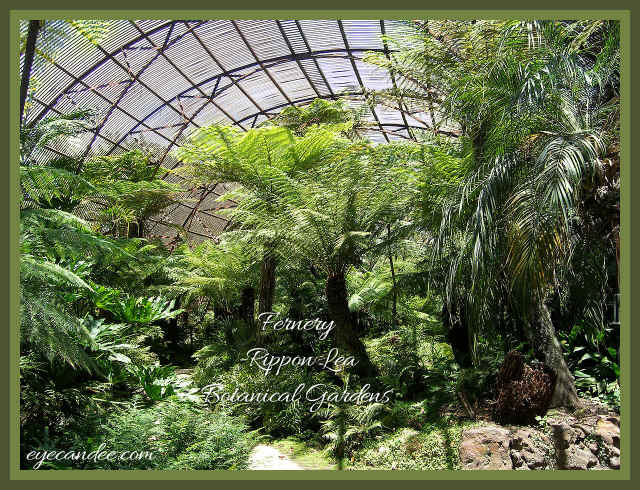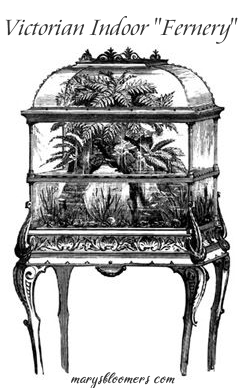 |
|
Most large botanical garden ferneries were in glass structures to provide a humid environment. Typical Garden Fernery designs can stand out in your yard as a part of a shade, foliage, rain or rainforest garden. A large fernery landscape, perfect for gardeners with big expanses of shade and some wet areas, and it can include large tree-height ferns to provide a canopy for lower growing ferns. Mine would be a combination, using several different themes. I enjoy the wild and primeval feel of lots of different textured foliage in different heights and shapes, and the tropical garden environment. Ferns are
also the perfect companion plants, due to the airiness and weeping appearance of
the fronds, for zen gardens. If you have shady areas or damp places, the garden's design can be a quiet and tropical seating area or an oasis in an un-used and un-loved nook. Ferns can be the main focus of a gardenscape that includes jungle, bog, or rainforest plants. |
Victorians had an obsession with indoor and outdoor ferns, and
"ferneries". In 1855, parts of Victorian England participated
in ‘pteridomania’ aka "the fern craze".
|
|
|
 |
 |
|
Fern plants are a type of vascular plant that belongs to the Polypodiopsida class of plants. They are also some of the oldest plants in the world. According to some estimates, there are over 10,000 species of ferns. Unlike many other types of plants, ferns don’t produce flowers. Most fern
species have fronds composed of blade-like leaves attached to a stem. Scientific classification distinguishes
between "true ferns" and several closely-related types of
plants known as "fern allies".
I learned something new!
In many countries, "ferneries" are indoors, or at least sheltered or kept in a shadehouse, to provide a humid environment, filtered light and protection from frost and other extremes. But some ferns are native to arid regions require protection from rain and humid conditions, and grow best in full sun. In mild climates, ferneries are often outside and have an array of different species that grow under similar conditions.
In 1859, the Fernery at Tatton Park Gardens, beside Tatton Hall, had been built to a design by George Stokes, to the west of the conservatory to house tree ferns from New Zealand and a collection of other ferns. In 1874, the fernery in Benmore Botanic Garden (Edinburgh), was built by a plant collector named James Duncan. This was a large and expensive project, since the fernery was based in a heated conservatory. In 1992, it was listed Historic Scotland for its architectural and botanical value, and has been described by the Royal Commission on the Ancient and Historical Monuments of Scotland as “extremely rare and unique in its design”. In 1903, Hever Castle in Kent was acquired and restored by an American millionnaire, William Waldorf Astor, who used it as a family residence. He added the Italian Garden, including a fernery, to display his collection of statuary and ornaments. Ferny FolkloreFerns are a subject of legends featuring mythical flowers or seeds.-In Slavic folklore, ferns are believed to bloom once a year, during the Ivan Kupala night. Although alleged to be exceedingly difficult to find, anyone who sees a fern flower is thought to be guaranteed to be happy and rich for the rest of their lives. -Finnish tradition is that anyone who finds the seed of a fern in bloom on Midsummer Night will, by possession of it, be guided and be able to travel invisibly to the locations where eternally blazing Will o' the wisps called Aarnivalkea mark the spot of hidden treasure. These spots are protected by a spell that prevents anyone but the fern seed-holder from ever knowing their locations. -In the US, ferns are thought to have magical properties. A dried fern can be thrown into hot coals of a fire to exorcise evil spirits, and smoke from a burning fern is thought to drive away snakes and other such creepy creatures. Planting Ferns in Your GardensFerns are native to woodlands and forests, and re-creating their native environment is the best way to ensure your ferns will thrive. Most will not grow well in full sun, but ferns like the cinnamon fern and the lady fern tolerate more sun than most. Ferns love dirt that is rich in nutrients and organic matter, which mimics the leaf-strewn soil of their forest homes. When planting, add generous amounts of leaf mulch or other composted material, and top dress the plants annually with a mulch of organic matter, such as pine needles or bark. Select a location for planting that has rich soil and plenty of organic matter, or amend your soil to replicate that. The site should be in partial to full shade, or indirect morning sun. Dig a hole large enough for the root ball. Mix some compost/manure into the soil at the bottom of the hole and place the fern in the hole with the top of the root ball at grade. Backfill with soil, firming the top to keep the plant from toppling over. Water generously for the first few weeks until the plant is acclimated. If you are planting multiple ferns, note that most ferns multiply by underground rhizomes, so leave space between them to allow for growth. If planting in a container garden, no need to worry about spreading and invasion. I like a "mobile garden" plan, so that i can move and redesign my gardens and not have to dig anything up. I also want to avoid weeding and trying to get weeds out through the airy and feathery fronds of ferns. Been there and I don't like that chore. Care and Feeding Your Garden FernsFerns prefer moist but not soggy soil. Ferns that are growing in sunlight or in containers will dry out quicker than plants in the ground and in the shade. Fertilize your garden ferns monthly in spring and summer with organic fertilizers like epsom salts or fish emulsion. In the northern part of the U.S., your ferns will usually die back in winter, or you can cut them back in fall. ReproductionFerns are unique in that they do not produce seeds or flowers. They reproduce by way of spores that form on the underside of the fronds. In nature, these spores are spread by the wind. You can try planting them yourself by shaking them from a mature leaf and placing in potting soil. It may take several months for them to sprout. Remember that in the garden, wind-blown spores will create new plants, so show diligence, if necessary, in order to keep them from spreading in areas you want to keep them out of. If you are growing a naturalized or wild area, the wind is your friend! Pruning Pruning ferns is unnecessary. They usually die to the ground in winter, and in the spring, new fronds will pop up from the central cluster to start the growing season. Dead leaves can be gathered up and cleared away. I cut dead fronds from mine for aesthetic reasons if the plant is showcased or somewhere highly visible. Pests and diseasesMost ferns are hardy plants with very few
pests. Common infestations include mealy bugs, nematodes, and mites. If you can
catch them early enough, it’s possible to prune away the infested leaves and
save the plant. Diseases common to ferns include bacteria blight, leaf tip burn,
and blight. Always clear away dead leaves and debris in the spring to
avoid the possibility of fungal diseases on the plants. Recommended Garden FernsMy favorites are
Japanese Painted and Cinnamon Ferns. As always, check the USDA hardiness zones and choose the plants that will grow and thrive in your region.
You
can download this awesome and free 1894 Illustrated book about
ferns and their care in .pdf format. Click the book to begin your free download.
Quick Links Content, graphics and design ©2021 marysbloomers.com This
site uses Watermarkly Software |









